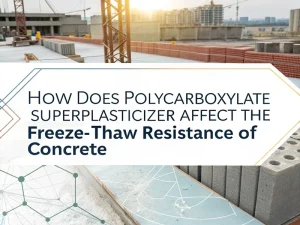
The Influence Of Polycarboxylate Superplasticizer On The Setting Time Of Concrete
Blog The influence of pol
Blog
In the world of high-performance concrete, polycarboxylate superplasticizer (PCE) is undoubtedly the king. It endows concrete with unprecedented fluidity, strength, and durability. But have you ever wondered where the root of this magical performance lies? The answer does not come from the final PCE polymer, but from its most fundamental building unit – Polycarboxylate Polyether Monomer.
Polycarboxylate Superplasticizer Monomers are like the “genetic code” of PCE. Different monomer choices and combinations pre-design the final PCE polymer’s behavior at the molecular level, ultimately determining the macroscopic properties of concrete, such as initial flowability, workability retention ability, and strength development.
This guide will delve into the core of chemistry and reveal how these key monomers (such as VPEG, TPEG, and HPEG) affect and control the performance of concrete from the source.
To understand the role of monomers, it is first necessary to visualize the structure of PCE polymers. It is commonly referred to as a “comb-like polymer” and consists of two parts:
Backbone: usually polymerized from acrylic acid. It carries many negatively charged carboxyl groups (- COO ⁻), acting as an “anchor” responsible for adsorbing the entire molecule onto the surface of cement particles.
Side Chains: Provided by polyether monomers. These long, flexible chains extend into the aqueous phase, much like the “teeth” of a comb, pushing cement particles apart through steric hindrance to achieve efficient dispersion.
Therefore, polyether monomers are the raw materials for constructing these key “side chains”. The chemical structure of the monomer directly determines the length, density, and morphology of the side chains, which in turn determines the overall performance of PCE.
In industrial production, several mainstream polyether monomers are widely used, and their names (such as VPEG and TPEG) represent the differences in their chemical structures, particularly the distinct “active double bond” groups used for polymerization at their ends.
VPEG (vinyl polyoxyethylene ether): with vinyl as the terminal group.
HPEG (Allyl polyoxyethylene ether): with Allyl as the terminal group.
TPEG/EPEG (Isoprenol polyoxyethylene ether): with Isoprenol as the terminal group.
The key difference lies in the reactivity of polymerization reactions: the terminal double bonds of TPEG/EPEG have higher reactivity, while the reactivity of VPEG/HPEG is relatively lower.
This seemingly small chemical difference has a profound impact on the final synthesized PCE polymer structure, ultimately translating into significant differences in concrete properties.
By selecting different monomers and controlling the polymerization process, we can “design” PCE molecules with different side chain lengths and densities.
Side chain length: determined by the molecular weight of the polyether monomer. The larger the molecular weight of a monomer, the longer the side chains formed.
Effect: Longer side chains provide stronger steric hindrance, like longer levers, which can more effectively push away cement particles. This typically results in a higher initial water reduction rate.
Side chain density: refers to how many side chains are connected to the main chain. This is mainly influenced by the monomer reaction activity and the polymerization process.
Effect: Due to the high reactivity of monomers such as TPEG, it is easier to synthesize PCE with high side chain density. The high-density side chains form a more “dense” protective layer, which can more effectively prevent the coagulation of cement particles and slow down the speed at which PCE molecules are encapsulated by hydration products. This usually means better slump retention ability (slump retention).
It is worth noting that modern PCE synthesis technology has surpassed the application of single monomers. R&D personnel can now customize more refined performance through the following methods:
Polymerization: Mixing different types or molecular weights of monomers (such as long-chain TPEG and short-chain TPEG) together for polymerization, resulting in PCE molecules with varying lengths of side chains, thus balancing initial water reduction rate and long-term slump retention.
Functional monomer introduction: Introducing other special monomers during polymerization to give PCE additional functions, such as air entrainment, retarding, and enhancing adaptability to soil.
The influence of polycarboxylate ether monomers on the properties of concrete is fundamental. It is not an isolated chemical concept, but rather a bridge connecting molecular design with macroengineering applications.
By understanding the differences in reaction activity and molecular structure of various monomers, such as VPEG and TPEG, and how these differences translate into variations in PCE polymer side chain length and density, we can predict and control the workability of concrete from the source.
For additive developers, monomer selection is the starting point for performance design; For concrete technology experts, understanding the underlying principles is the key to choosing the right PCE products to solve complex engineering challenges. In the future, with deeper research on monomer chemistry and polymerization technology, we will be able to “program” PCE with superior performance and more customized functions, promoting concrete technology to new heights.

The Influence Of Polycarboxylate Superplasticizer On The Setting Time Of Concrete
Blog The influence of pol

How Does Polycarboxylate Superplasticizer Affect The Freeze-thaw Resistance Of Concrete?
Blog How does polycarboxy